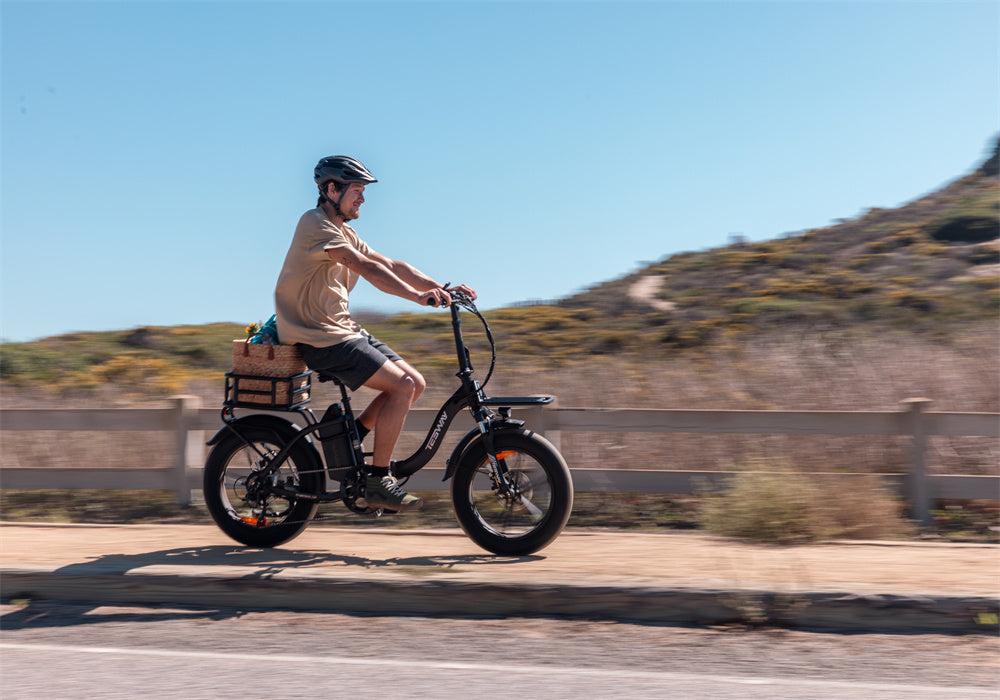I didn’t learn to ride a bicycle when I was a kid, and maybe you didn’t either. But guess what? That’s perfectly okay! You can still experience the thrill and joy of cycling, and with the rise of ebikes, it’s never been easier. Electric bikes offer a fantastic way to get outdoors, stay active, and embrace a new sense of freedom. Let’s get started!
What is the Difference Between an E-Bike and a Traditional Bicycle?
Riding an e-bike is like riding a traditional bicycle, but with some extra perks that make the experience even more enjoyable. An ebike is equipped with an electric motor that assists you while pedaling, making it easier to ride, especially on hills or longer distances. Traditional bicycles rely solely on your pedaling power, which can be more physically demanding.
Electric bicycle come with a battery that powers the motor, and they often have different levels of assistance that you can adjust based on your needs. For instance, you can use a higher level of assistance when climbing a steep hill and a lower level on flat terrain to save battery life. Traditional bicycles don’t offer this kind of flexibility, which can make long rides more challenging.
Additionally, ebikes are generally heavier than traditional bicycles because of the motor and battery. This added weight can affect handling and maneuverability, particularly at lower speeds. However, the motor assistance more than makes up for this, providing a smoother and less strenuous riding experience.

Different Classes of Electric Bicycle You Should Know
Ebikes come in various classes, each with its own features and regulations.
Class 1 e-bikes have a motor that assists you only while you’re pedaling and stops providing assistance when you reach 20 mph. These bikes are perfect for beginners because they offer a straightforward and intuitive riding experience. They are usually allowed on bike paths and multi-use trails, making them versatile for different environments.
Class 2 e-bikes feature a throttle that can propel the bike without pedaling, but the motor assistance cuts off at 20 mph. This class gives you more flexibility, allowing you to take breaks from pedaling while still moving. However, be sure to check local regulations, as some areas may have restrictions on where Class 2 electric bikes can be used.
Class 3 e-bikes are similar to Class 1, but the motor assists up to 28 mph. These bikes are designed for more experienced riders who need a bit more speed for commuting or longer rides. They are typically restricted from bike paths and trails because their higher speeds can pose safety concerns for pedestrians and other cyclists.
Choosing the right class depends on your riding goals and where you plan to use your e-bike. If you’re just starting out, a Class 1 e-bike might be the best choice, offering a good balance between assistance and a traditional biking experience. For those seeking more versatility or speed, Class 2 or Class 3 electric bikes could be ideal.

What Style of E-Bike is Suitable for Me?
Ebikes come in various styles, each designed to suit different types of riding and rider preferences.
City ebikes are designed for urban environments and commuting. They typically feature a comfortable upright riding position, which is easier on your back and shoulders. These bikes often come equipped with practical accessories like fenders, racks, and lights, making them ideal for daily use. If you plan to use your e-bike for commuting or running errands around town, a city e-bike is a great choice.
Mountain ebikes are built for off-road adventures. They have robust frames, suspension systems, and wider tires to handle rough terrain. These bikes are perfect if you enjoy exploring trails and need a bike that can handle the demands of off-road riding. Keep in mind that mountain e-bikes can be more challenging to ride for beginners due to their higher weight and complex features.
Hybrid e-bikes combine features from both city and mountain bikes, offering versatility for various riding conditions. They provide a balance between comfort and performance, making them ideal for riders who want to use their e-bike for both commuting and recreational purposes. Hybrids often have moderate suspension and tire width, allowing them to handle both paved roads and light trails.
Folding ebikes are compact and convenient for those with limited storage space or who need to combine cycling with other forms of transportation, such as public transit. These bikes can be easily folded and carried, making them a practical option for urban commuters. However, they typically have smaller wheels and a less powerful motor, which can limit their performance on longer rides or rough terrain.
You can find all the above types of ebikes at TESWAY! Generally speaking, ebikes are more expensive. But you could buy an ebike at a more affordable price at TESWAY.

How to Learn to Ride an E-Bike for an Adult
Learning to ride an e-bike as an adult can seem daunting, but with the right approach, it can be a fun and rewarding experience.
Start with the basics. Before you hit the road, it's essential to familiarize yourself with the basic controls and features of your e-bike. Take some time to learn how to turn the motor on and off, adjust the level of assistance, and use the throttle if your e-bike has one. Practice these controls in a safe, open area where you can get comfortable without the distraction of traffic or other obstacles.
Focus on balance and steering. One of the most critical skills in cycling is maintaining balance. Start by practicing balancing on your e-bike while stationary. Once you feel comfortable, begin riding at a slow pace, focusing on keeping your balance and steering smoothly. Remember that electric bikes are heavier than traditional bikes, so it may take some time to get used to the added weight.
Practice braking. Ebikes often have more powerful brakes than traditional bicycles, so it's crucial to practice using them effectively. Find a safe area where you can practice stopping and starting, gradually increasing your speed as you become more confident. Learn to use both the front and rear brakes to stop smoothly and safely.
Get comfortable with the pedal-assist. One of the unique features of ebikes is the pedal-assist, which provides additional power as you pedal. Start with a low level of assistance and gradually increase it as you become more comfortable. Pay attention to how the motor engages and learn to use it to your advantage, especially when climbing hills or accelerating from a stop.
Ride in a straight line. Practicing riding in a straight line is essential for building confidence and control. Find a quiet, straight path where you can focus on maintaining a steady course. This practice will help you develop the muscle memory needed to ride smoothly and confidently.

Navigate turns and corners. Once you're comfortable riding in a straight line, start practicing turns and corners. Begin with gentle turns and gradually work your way up to sharper corners. Remember to slow down before turning and look in the direction you want to go. Lean slightly into the turn and use your body to help guide the bike.
Practice in different environments. To become a well-rounded rider, it's important to practice in various environments and conditions. Start with flat, smooth surfaces and gradually progress to more challenging terrain, such as hills, gravel paths, or trails. This practice will help you develop the skills needed to handle different riding conditions confidently.
Learn road safety rules. Understanding and following road safety rules is crucial for riding an e-bike safely. Familiarize yourself with local traffic laws, including where you can and cannot ride your e-bike. Always wear a helmet and other protective gear, and use lights and reflectors to make yourself visible to other road users.
Build endurance gradually. Riding an e-bike can be physically demanding, especially if you're not used to regular exercise. Start with short rides and gradually increase the distance and duration as your fitness level improves. Listen to your body and take breaks as needed to avoid overexertion.
FAQs
Is it difficult to learn to ride an e-bike as an adult?
Learning to ride an e-bike can be a bit challenging at first, especially if you have no prior experience with bicycles. However, with practice and patience, most adults can become comfortable riding an e-bike within a few days or weeks.
What should I look for when buying my first e-bike?
When buying your first e-bike, consider factors such as the type of riding you plan to do (commuting, recreational, off-road), the motor and battery specifications, the bike's weight, and any additional features like suspension, lights, and racks. It's also important to choose an e-bike that fits your budget and meets your personal preferences.
Do I need a license to ride an e-bike?
In most areas, you do not need a license to ride a Class 1 or Class 2 e-bike. However, regulations can vary by location, so it's important to check local laws regarding e-bike use. Class 3 e-bikes, which can reach speeds of up to 28 mph, may have more stringent regulations.







Share:
Does E-Bike Tire Size Really Matter
Stay active and Healthy | Could You Ride A Bike While Pregnant